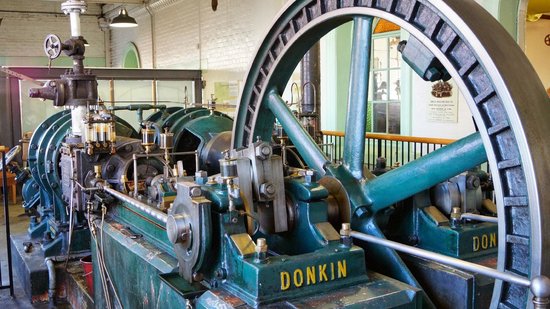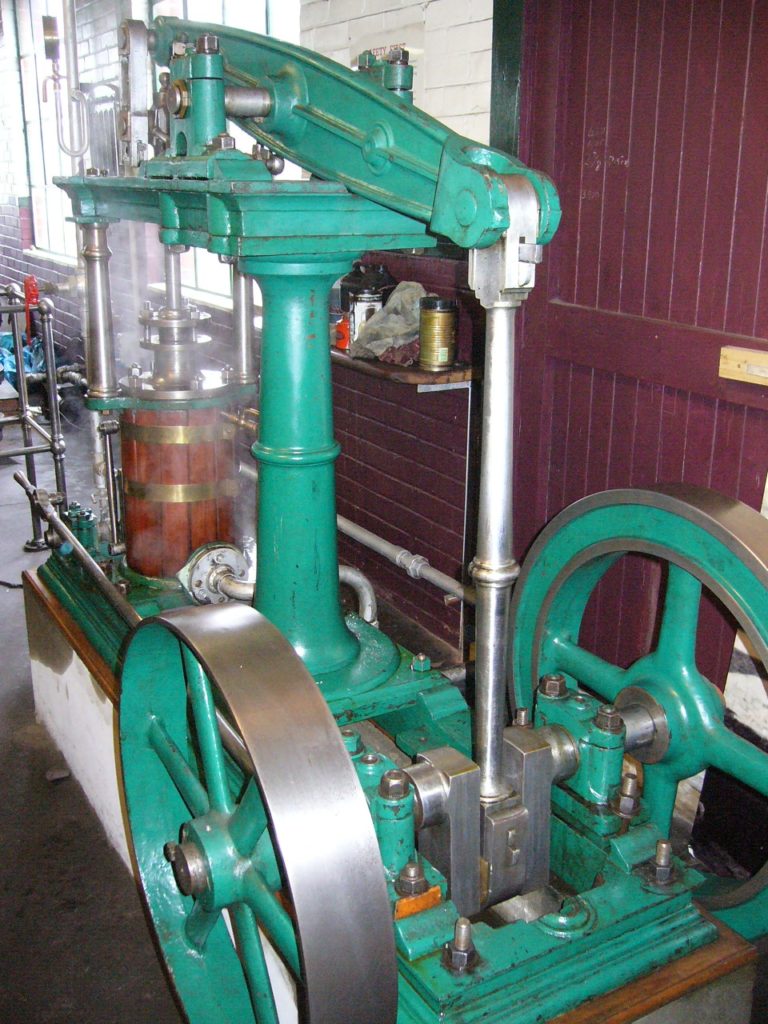Still working: the world’s best example of Victorian era gasworks machinery.
The university town of Dunedin is home to numerous museums, from the prestigious Otago Museum to the small Maritime Museum at Port Chalmers. However, one of the least known in the city is in fact, one of the most unique museums in Australasia.
Opened in 2001, the Dunedin Gasworks Museum is a significant world heritage site. It is a place where the sounds and smells of Victorian era machinery take you back to a time when the world’s industry was steam driven, a time of monumental change and innovation.
There are only three operating steam powered gasworks in the world. The other two are in Britain. The main attractions in the Dunedin museum are the fully operational steam engines in the Engine House. Many hours of loving attention have ensured these wonderful survivors of Victorian industrial technology are there to captivate future generations.
The Dunedin Gas Works was the first gas plant to open in New Zealand and the last to close. After it ceased operation, most of the complex was demolished but a small band of enthusiasts managed to save what has become the museum we see today. The chimney, built in the late nineteenth century, is the oldest remaining structure. The grimy brick industrial buildings that remain on the site would fit perfectly as background to a Charles Dickens story.
EARLY HISTORY
When the British settlers arrived in New Zealand in the early 1800s, they worked hard to establish themselves in this far away land. The southern settlement of Dunedin was established in one of the colder parts of the country and those who tried to make a home there found the climate too harsh and many eventually moved north. It appeared, the fledgling town was doomed to be nothing more than an isolated settlement without much of a future. However, in 1861, the population decline abruptly stopped when gold was discovered in Central Otago. Dunedin’s fortunes changed dramatically when gold revenue began flooding into the town. At the same time, it became the main supply centre for the thousands who flocked from around the world to mine the gold.Dunedin early 1900s
RAPID DEVELOPMENT
Demands for services and goods grew unchecked and “Mudedin” as it was called because of the mud the locals had to contend with, was forced to change from a frontier settlement into a town with more sophisticated facilities. Lighting the town’s streets was one pressing need and in 1862, the Dunedin Gas Light and Coke Company was formed. Engineer Stephen Stamp Hutchison made the move from the London Gas Works to Dunedin to oversee the establishment of the first gas works in New Zealand.
Over the years, a series of improvements were made to the complex. A new Retort House was constructed in 1906, along with a new 1 million cubic foot gas holder. In 1927, a Vertical Retort House, where coal was heated to produce gas, was built with the surviving Bryan Donkin Booster being installed. This amazing piece of engineering, manufactured in Chesterfield, England, compressed 100,000 cubic feet of gas per hour and was used during times of high demand to ensure the whole city received an adequate gas supply. In 1962, a more modern Retort House replaced the initial one and when this finally ceased operation in 1987, the gas works closed its doors for good.
Gas was ignited at the plant in May 1863 making it the first gas works in New Zealand. It took a further four months before the contract to supply 150 street lamps was actually fulfilled. The cost of 25 shillings per 1000 cubic feet of gas, was expensive, so the majority of home users stayed with their oil lamps, but there was still an insatiable demand for gas from the new industries being established to meet the increasing demand from a rapidly expanding, gold rich town.
FILTHY WORK
Although there was a wide range of positions from bricklayers to electricians, coalies, retort men, storemen, drivers and foremen, the gasworks was not a popular place of employment. Conditions were extremely unpleasant with coal dust constantly in the air and noisy machinery clanging around the complex, not to mention the unpleasant smell in the air. At times of high employment, it was difficult to recruit or retain staff. However those who did remain for long periods were pleased to have steady work even if it was unhealthy and often dangerous.
MY CHILDHOOD MEMORIES
Growing up in South Dunedin, I can still remember the pungent odours produced by the Dunedin Gas Works. Sitting with my sister in the back seat of our car as dad drove us along Anderson’s Bay Road to and from town, we would squeeze our nostrils closed as we passed the gasworks. Some days, the stench of gas, mixed with an odour of hot tar, hung in the air. The smell seemed to cling to the nostrils for ages.
DUNEDIN GAS WORKS MUSEUM
The Dunedin Gas Works Museum was created by a small band of enthusiasts who were enchanted by the intriguing machinery left to rust in the abandoned buildings.
The museum’s main attractions are the fully operational steam driven machinery in the Engine House. Many hours of loving attention have ensured these wonderful survivors of Victorian industrial technology are there to captivate future generations as they hum and purr in a controlled dance. With names such as Atmospheric, Rotative Beam and Horizontal, the engines could be characters from a children’s storybook. The Bryan Donkin Booster whispers a repetitive, hypnotic chant that almost sounds human.
The Waller Exhauster, produced at G. Waller and Sons Ltd of Stroud, Gloucestershire, has a muted hiss that is strangely soothing. The rhythmical ‘ker cha, ker cha’ of the beautiful little Beam Engine is soporific and is one of only two ever built at the Garrison Foundry in Falkirk, Scotland.
After I experienced the Engine House in full operation, with the tang of hot metal, combined with steam and warm oil hanging heavily in the air, it gave me an insight into a bygone era when machines were solidly built to last and when size mattered and moving parts worked in harmony to produce energy for factories manufacturing commodities for a new order which grew from the Industrial Revolution of the mid 1800s.
RESTORATION
After a 1 million dollar restoration in 2009, the Fitting Shop is also a major attraction on the site. Built in 1900, it was the scene of a major explosion in 1903 which almost completely destroyed the building and broke windows in houses within a wide radius of the gasworks.
I was so impressed with the Gas Works Museum that I offered to write a feature on it for ‘Old Glory’, a British magazine that focuses on steam technologies. They published my story and were impressed with the fact, it is one of only two operating steam powered gasworks outside Britain.
Another major attraction at this unique museum is the Ruston Steam Shovel. These ugly machines were the earliest form of powered shovels and were used to build the Panama Canal. I’ve been fortunate to see this Dunedin steam shovel in action. The clanging it makes as the huge bucket creaks and groans as it swings into action is somewhat intimidating. The roar of the fire in the boiler, with black smoke puffing from the slender chimney at the rear of the cabin, adds to the interest of this early 20th century machine in action. Today, the Dunedin shovel lies silent but to wander around its bulk gives a good impression of a machine designed for heavy work a century ago.
This short video shows a steam shovel from the same period in action.
https://www.youtube.com/watch?v=c9Ei3RcLFuo
It is heartening to know that the micro chip generation is showing interest in the huge, heavy, noisy, greasy machinery that was created by Victorian inventors who strived to make life in their world easier, just as the diminishing size of current digital technologies is doing in today’s world.
Please leave a comment. I’d love to read what you think about my blogs.
Ceidrik Heward
Ceidrik Heward is an Amazon TOP SELLING AUTHOR and has lived and worked in 7 countries working as a TV cameraman, director and film tutor. For the past 17 years he has focused on writing and has been published in magazines and newspapers in Europe, USA, Asia and the Middle East.
His interests include photography, psychology and metaphysics. He loves to read and always has at least 3 books on the go. He has written 22 manuals/books and has just completed his 4th short novel. Ceidrik believes sharing information and stories is the best way to stimulate the imagination and enrich our lives.
























 Visit Today : 338
Visit Today : 338 Total Visit : 1133515
Total Visit : 1133515
Found this blog very interesting. Dunedin was definitely a City of many firsts.